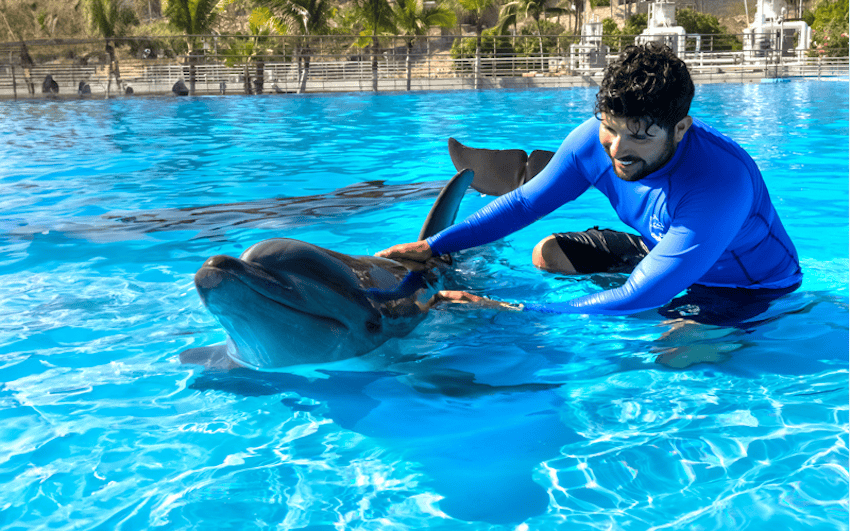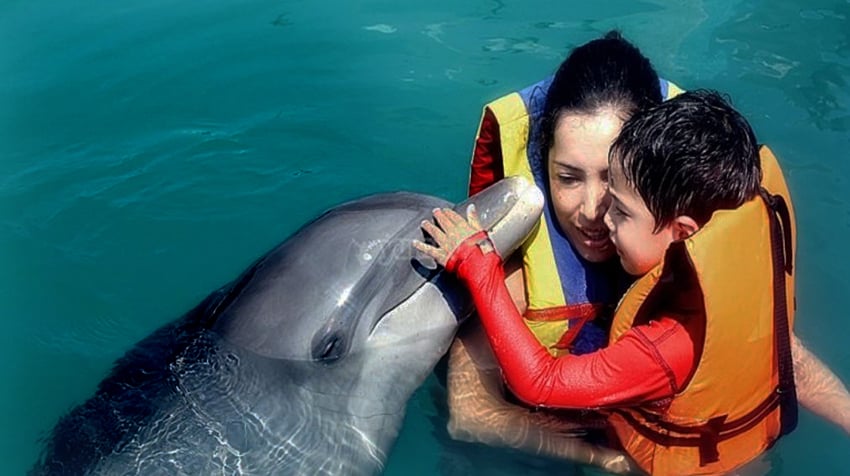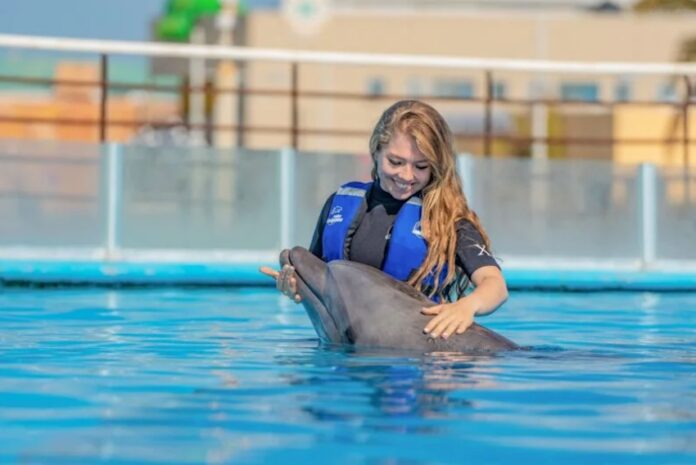On November 28, 2020, a then-30-year-old dolphin named Mincho was badly injured while performing for tourists at the Barceló Maya Grand Resort on the Riviera Maya. He leapt high into the air during a dolphinarium show but missed his landing spot in the pool, crashing headlong onto a concrete platform.
Mincho had been plagued by vision problems in one eye, which was a likely factor in the accident. Two days later, despite a veterinarian’s counsel for rest, Mincho was performing again. Five years later, in February 2025, a video of the incident finally leaked and quickly went viral, contributing to a groundswell of support for animal rights, in particular, wild animals forced into captivity to perform tricks for the amusement of people.
By June, both Mexico’s Senate and its Chamber of Deputies had unanimously passed new legislation to tighten protections for captured marine mammals, and President Sheinbaum had helped prioritize its swift enactment into law on July 17. Known as Mincho’s Law, it contains several provisions, including bans on capturing more marine mammals for entertainment purposes or the captive breeding of those already in dolphinariums. Acrobatic demonstrations as part of commercial entertainment shows, such as the one in which Mincho was injured, are now illegal.
What have the effects of the law been so far in Los Cabos?
What remains to be seen is the long-term impact of this law on the estimated 30 dolphinariums still open in the country, and their 350 captive dolphins. As a resident of Los Cabos, I’ve been particularly interested in how the law is enforced here, given that dolphin experiences have long been one of the most popular local activities for visiting tourists.
For starters, there was a connection between the Mincho incident and Los Cabos. The dolphinarium closed due to Mincho’s injury (and the failure to report it) was owned by The Dolphin Company, which also owned Dolphin Discovery in Los Cabos before that business closed and the company behind it declared bankruptcy (perhaps not coincidentally, the same month video of Mincho’s accident went viral). Open for over a decade locally in San José del Cabo, Dolphin Discovery welcomed over 200,000 visitors.
That means the only dolphinariums of note still open in Los Cabos are owned by Cabo Adventures, which continues to offer experiences in Cabo San Lucas and San José del Cabo (although no longer under its former Cabo Dolphins branding). On July 18, the day after Mincho’s Law went into effect, Cabo Adventures announced to its partners that it complied with the new law in all respects.

How has Mincho’s Law changed dolphin experiences in Los Cabos?
The company that owns Cabo Adventures, The Adventures Group, also owns Vallarta Adventures and Cancun Adventures. On July 21, it released a statement on social media, noting that, due to the recent law, it would be making important adjustments to its dolphin experiences. “In place of the previous activities,” the release said in part, “you will now enjoy extended interaction time, more direct contact, and unique moments that will allow you to emotionally connect with these incredible creatures in a way that is both enriching and respectful.”
What does this mean in terms of available activities? The emphasis on one-on-one time with dolphins, rather than any of the dolphin acrobatics now prohibited, is a focus of the revised slate of activities at Cabo Adventures, which includes dolphin swims, experiences, and encounters. Educational briefings and sessions with experts on these marine mammals are also included in all tours. The company is also certified for the treatment and well-being of its dolphins by the American Humane Society, a certification received in 2019, before the enactment of Mincho’s Law.
What’s next based on the law’s compliance provisions?
Despite current compliance, there are still hurdles to clear for dolphinariums in Los Cabos and elsewhere in Mexico based on transition period provisions in the new law. For example, by 90 days from the implementation of Mincho’s Law on July 17, all dolphinariums must provide inventories to Mexico’s Secretariat of Environment and Natural Resources (SEMARNAT). Included in these inventories are not only the age and sex of all the dolphins or other marine mammals they possess, but also microchip identification numbers, veterinary health histories of each dolphin, and information on their housing conditions.
Speaking of the latter, by 18 months after the law’s enactment, concrete pools must be removed and the dolphins relocated to sea pens. However, there is an alternative for dolphinariums where such a move is not technically feasible, which, by the way, must be demonstrated via engineering assessments. In these cases, the pumping in of circulated seawater may be permissible.

This is to say that Mincho’s Law does have teeth. Dolphinariums that fail to meet these benchmarks may be subject to progressively increasing fines or have their licenses revoked and be permanently closed. However, for those who wanted to see these captive dolphins liberated, at least in cases where they might be successfully reintroduced into the wild, that seems unlikely, at least in dolphinariums committed to remaining in compliance with the new law.
Mincho’s Law is part of a larger movement
What is clear, though, is that there is a sea change taking place in Mexico regarding the exploitation of animals. In April, Baja California joined Michoacán and Nuevo León among states in Mexico that have legally recognized animals as sentient beings, with all the protections that implies. That followed a historic win for animal rights activists in March, when a law banning violence in bullfights was passed in Mexico City.
The law against using captive dolphins for entertainment rather than education or scientific purposes is just the latest example of this movement towards better treatment for animals. The closure of the dolphin facility where Mincho was injured and the 7.5 million peso fine against its operators were a step in the right direction, and the agency responsible for these actions, the Federal Attorney for Environmental Protection (PROFEPA), is planning to make regular inspections of all the nation’s dolphinariums in the future.
Chris Sands is the Cabo San Lucas local expert for the USA Today travel website 10 Best, writer of Fodor’s Los Cabos travel guidebook and a contributor to numerous websites and publications, including Tasting Table, Marriott Bonvoy Traveler, Forbes Travel Guide, Porthole Cruise, Cabo Living and Mexico News Daily. His specialty is travel-related content and lifestyle features focused on food, wine and golf.
